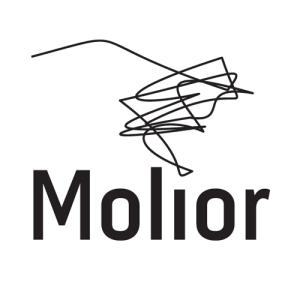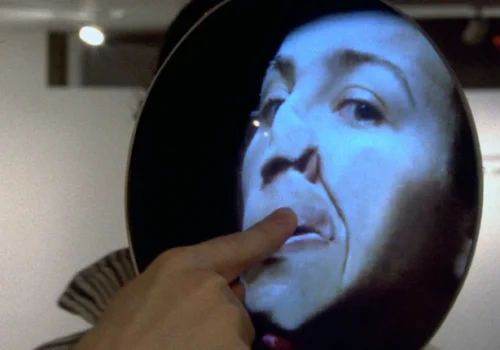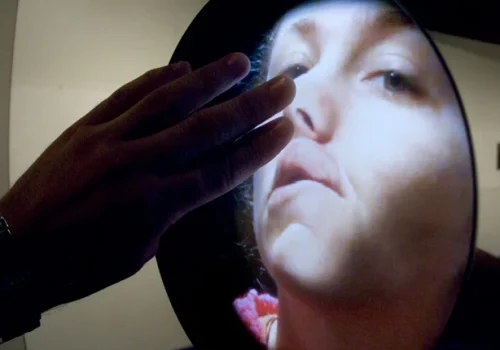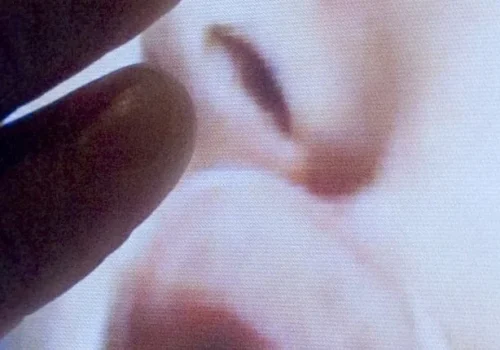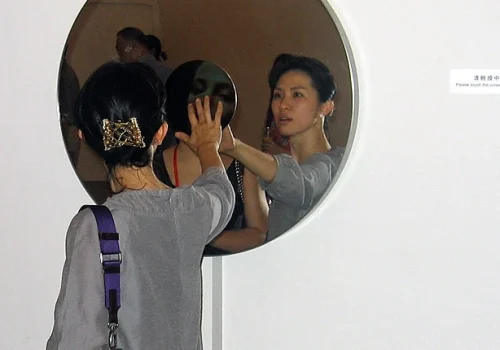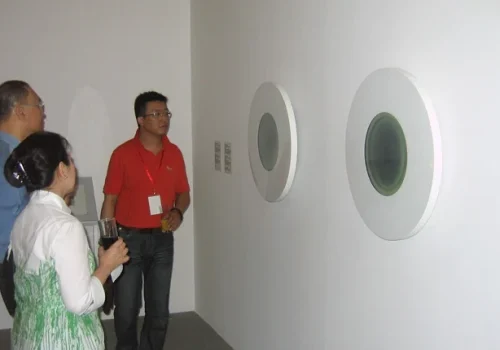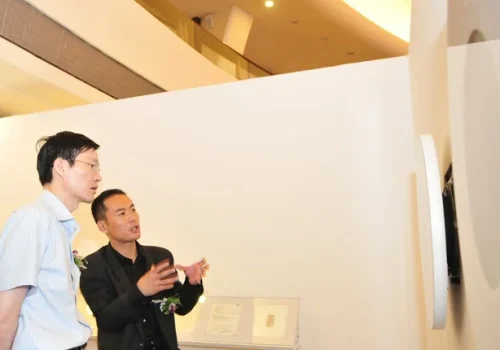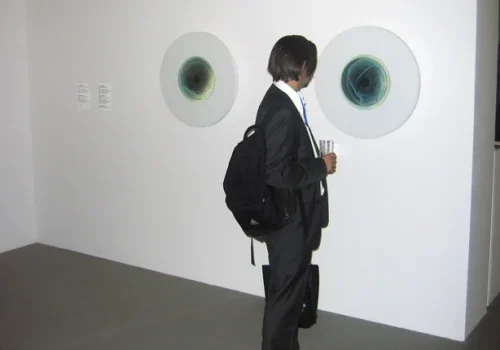eARTS BEYOND : Shanghai International Gallery Exhibition of Media Art
Tour de la Perle d’Orient, Shanghai
From September 10th to September 20th, 2009
Mr. Zhang Ga, artistic, director for eARTS BEYOND and a key Molior partner, recently invited the organization to participate in the major event.
Presented in the spectacular Oriental Pearl Tower in Shanghai, the exhibit will include projects by Jean Dubois and Luc Courchesne, through Molior’s participation.
A number of remarkable works have been assembled for the exhibition. Leading artists such as Marina Abramovic, Jim Campbell, Joseph Kosuth, Bill Viola, and David Rokeby are among those invited.
eARTS BEYOND is a platform for promoting new practices in media and contemporary arts. The event is designed to foster recognition of this art form and enhance its presence in the contemporary art market.
This is not the first time Molior has worked with Zhang Ga. As the new media consultant and curator for the National Art Museum of China (NAMOC), Mr. Zhang invited the organization to exhibit Canadian artists in Synthetic Times – Media Art China as part of the cultural events surrounding the 2008 Beijing Olympics.
Zhang Ga
Zhang Ga is a media art curator, professor of Media Art at Academy of Arts and Design, Tsinghua University (Beijing), and associate professor of Media Design at the School of Art, Media and Technology at Parsons The New School for Design (New York). He also holds appointments as Consulting Curator of Media Art at the National Art Museum of China, Senior Researcher at the Media x Design Lab of EPFL | Swiss Federal Institute of Technology Lausanne and Visiting Scientist at the MIT Media Lab in the U.S. He was Artistic Director / Curator of Synthetic Times: International New Media Art Exhibition, a Beijing Olympics Cultural Project organized by the National Art Museum of China in 2008 (catalogue by the MIT Press), among numerous other curatorial projects. He has been on many jury and consultation committees including the (former) World Trade Center Artist Residency Program, Rockefeller New Media Fellowship National Nomination Committee, Prix Ars Electronica among others. He organized and curated the First, Second and Third Beijing International New Media Art Exhibitions and Symposiums, extending the global new media art discourse into mainland China. He has lectured widely around the world; most recently he was a keynote speaker at Re:Live09, Third International Conference on the Histories of Media Art, Science and Technology. In 2010, he founded China’s first media art lab at Tianghua University.
Artists & works
Jean Dubois
Tact
2000-2001
Interactive installation
Description of the work
Tact is an interactive video installation that can be controlled using a touch-sensitive screen. It sets up a meeting between the participant and an anonymous person located on the other side of the screen. The Tact program links video sequences in response to the participant’s various manipulations. Without using words, participants are invited to engage in gesticulative dialogue. By touching and rubbing, they eventually discover they are provoking unusual reactions from their virtual partner.
Literally, the word “tact” is synonymous with the sense of touch. Figuratively, however, it also means an intuitive, spontaneous and thoughtful appreciation of how it is appropriate to behave in a human relationship. The Tact project demonstrates the increasing presence of electronic mediation in interpersonal exchanges. The recent emergence of various network communication services (e-mail, forums, electronic chat) is giving rise to a particular type of public space where social relations are often filtered by anonymity or artificial identities. In many cases, these can be seen as an opportunity for openly expressing ourselves with others without actually exposing ourselves personally. Technology then plays a paradoxical role in that it provides direct access to others while maintaining a protective distance. In this kind of relationship, a strange mixture of inhibition and exhibition seems to appear.
Biography
From the start Jean Dubois has focused his research on the interactions of the body and technological devices, notably the touch screen and mobile telephony, as well as on the intersubjective relationships that underpin them. His work also draws on a combinatory textuality structured around mots-valises, concrete poetry or polyphonic conversations.
His works have been shown in several art centres, museums, biennials and festival in Canada and abroad, notably at the Biennale internationale d’art numérique (Montreal), CyberFest at Hermitage Museum (Saint Petersburg), Biennale de Montréal, Incheon International Digital Art Festival (South Korea) and at the International Biennial of Media Art (Melbourne). Molior presented his interactive video panel Tact (2000-2001) in 2006 during the exhibition À l’intérieur/Inside put together by Sylvie Parent for the Third Beijing International New Media Arts Exhibition and Symposium at the Millennium Museum, and in 2009 as part of eARTS BEYOND: Shanghai International Gallery Exhibition of Media Art, under the artistic direction of Zhang Ga.
He teaches at École des arts visuels et médiatiques de l’Université du Québec à Montréal where, until just recently, he was the vice-dean of research and creation. He is also among the founding members of Hexagram, an interuniversity media arts research and creation centre and he was the chair of the board of directors of Vox, Centre de l’image contemporaine.
Luc Courchesne
Kujukurihama, Chiba, Japon
Bords de mer series
60 cm diam. x 16,5 cm
Description of the work
Having dealt with landscape and the idea of immersion for the last decade, Luc Courchesne’s photographic work has drawn out the visual and symbolic significance of boundaries, abrupt transitions, thresholds. In the last two years, adapting his panoramic optical systems to video, Courchesne has focused his attention on seashores—the locus, he finds, of perpetually changing boundaries, a kind of continuous negotiation between two states, the dynamic meeting of two emphatically different and mutually transformative substances. Here, Courchesne tells us, one may read a metaphor for interpersonal relationships and the occasion for a fascinating artistic experience that consists in observing a line formed and transformed in a process at once repetitive and random.
Biography
Luc Courchesne is a prominent pioneer in the digital arts field. He rapidly adopted computer technologies to create conversational video portraits. He then rendered the landscape in “panascopic” images that allowed for a visual immersion. His recent work consists of experiential devices that combine a virtual space with a horizon of human interactions, interactive immersive installations, and works exploring telepresence.
His work is regularly shown in Canada and abroad and he participated in several major events. In 1997, he was awarded the Grand Prize if the first NTT InterCommunication Center biennial in Tokyo, and in 1999 the Award of distinction in the Interactive art category of the Prix Ars Electronica in Linz, Autria. Molior presented his work at eARTS BEYOND: Shanghai International Gallery Exhibition of Media Art (Shanghai) in 2009 and at SYNTHETIC TIMES – Media Art China 2008, at the National Art Museum of China (NAMOC), Beijing in 2008.
An honorary professor at Université de Montréal, Luc Courchesne is also a founding member of the Society for Arts and Technology, co-director of the SAT | Metalab and a member of the Royal Canadian Academy of Arts. He is represented by Pierre-François Ouellette Art Contemporain.
His works are included in private collections and those of several public institutions, in particular the National Gallery of Canada, which acquired one of his interactive installations.
Luc Courchesne
Ocean Beach, San Francisco, Californie
Bords de mer series
60 cm diam. x 16,5 cm
Description of the work
Having dealt with landscape and the idea of immersion for the last decade, Luc Courchesne’s photographic work has drawn out the visual and symbolic significance of boundaries, abrupt transitions, thresholds. In the last two years, adapting his panoramic optical systems to video, Courchesne has focused his attention on seashores—the locus, he finds, of perpetually changing boundaries, a kind of continuous negotiation between two states, the dynamic meeting of two emphatically different and mutually transformative substances. Here, Courchesne tells us, one may read a metaphor for interpersonal relationships and the occasion for a fascinating artistic experience that consists in observing a line formed and transformed in a process at once repetitive and random.
Biography
Luc Courchesne is a prominent pioneer in the digital arts field. He rapidly adopted computer technologies to create conversational video portraits. He then rendered the landscape in “panascopic” images that allowed for a visual immersion. His recent work consists of experiential devices that combine a virtual space with a horizon of human interactions, interactive immersive installations, and works exploring telepresence.
His work is regularly shown in Canada and abroad and he participated in several major events. In 1997, he was awarded the Grand Prize if the first NTT InterCommunication Center biennial in Tokyo, and in 1999 the Award of distinction in the Interactive art category of the Prix Ars Electronica in Linz, Autria. Molior presented his work at eARTS BEYOND: Shanghai International Gallery Exhibition of Media Art (Shanghai) in 2009 and at SYNTHETIC TIMES – Media Art China 2008, at the National Art Museum of China (NAMOC), Beijing in 2008.
An honorary professor at Université de Montréal, Luc Courchesne is also a founding member of the Society for Arts and Technology, co-director of the SAT | Metalab and a member of the Royal Canadian Academy of Arts. He is represented by Pierre-François Ouellette Art Contemporain.
His works are included in private collections and those of several public institutions, in particular the National Gallery of Canada, which acquired one of his interactive installations.
